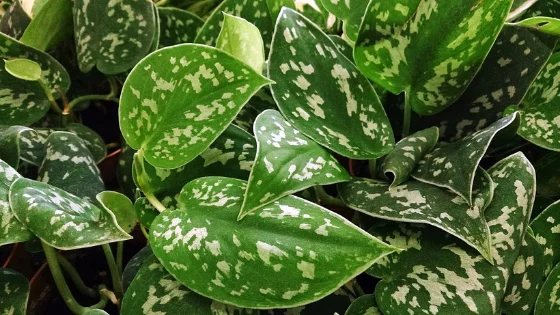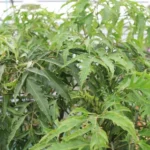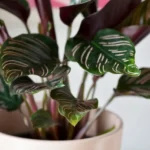Table of Contents
All About Scindapsus Plants
The scindapsus plant is a lovely leafy plant native to New Guinea, Southeast Asia, Queensland, and some western Pacific islands.
In their natural habitat, these flowering plants grow on the sides of trees and other tall structures.
Outside of their natural habitat and native countries, they are often seen as houseplants, growing in hanging pots or around fences.
They are easy to plant and to grow, making them perfect for many households whether the caregiver has experience or not.
There are numerous types of plants in the scindapsus genus. Four of them are very common as houseplants:
- Argyraeus, also known as Satin Pothos – this is the most common type. This name means “silvery”, and is derived from the colors splashed on its leaves.
- Exotica – This particular variety has larger leaves and more variation in color. It also has some differences in the edging on the leaves.
- Silver Satin – The shape of its leaves is similar to the Exotica variety but has less color splashing and variations on the leaves. It does have speckles that the Exotica doesn’t have, plus the leaves are different in their edging.
- Silvery Ann – This variety has a similar form and leaf size to the Argyraeus, but there is an additional color variation on the leaves. Most of the leaves are more than 50% silver and have splashes and speckles of color on the remainder of them.
Other variations in this genus include, but are not limited to, the Silver Splash, Silver Hero, Silver Lady, and Jade Satin.
These are named after the colors splashed and speckled on their leaves. There is also a white version of the plant, having a very unique but beautiful appearance.
Propagation
It is possible to propagate scindapsus plants through seeds and cuttings. Seeds are sold from different vendors locally and online.
Any buyer must make sure that the products to be purchased are legitimate as they can be mistaken with other similar types of seeds.
Even when the plants grow, they can be confused with similar greenery, such as that from the pothos genus.
When propagating using seeds, they can be placed into a pot or another form of container and covered with a potting mix.
The container, placed in a well-lit area, must have an excellent drainage system to prevent excess water from staying in the soil.
The plant should only be watered when the top inch or two of the topsoil is dry. A water-soluble half-strength fertilizer can be added to the potting mix each month to help the seedlings grow.
Propagation through cuttings is typically completed in the spring. A tip between three to four inches long may be cut just below a node.
Three or four cuttings should be placed around the rim in the soil of a pot that measures three inches in diameter. For best results, it is recommended to use a potting mix that is half coarse perlite potting mix and half peat moss.
The whole pot can then be enclosed in a plastic bag and placed in a light area until rooting occurs.
Once roots grow, the plastic covering is to be removed. With some care, after three months, each plant can be transferred into its own three or four-inch pot, or hanging basket.
Care and Growth
The propagation of the scindapsus genus is probably the most difficult part. As long as the caregiver offers these basic requirements, these plants can thrive in various locations and environments.
Light
This genus of plants can survive in low light, but they might not grow as large as they otherwise potentially can. In well-lit areas but out of direct sunlight, they thrive and grow quite well.
Temperature
The optimal temperature to keep these plants healthy is between 18-29 degrees Celcius (65-85 degrees Fahrenheit).
Humidity
Air humidity levels of around 40% or more works better for this genus.
Water
Watering must only occur when the top inch or two of the soil is completely dry. However, it can be left even longer, until the leaves start to curl. Some professionals prefer to wait until the leaves curl to prevent overwatering.
Soil
A quick-draining potting mix is the recommended type of soil. Ingredients such as bark, perlite, or other similar additives are excellent. It’s possible to use certain types of cactus mix as well.
Fertilizer
For best results, add fertilizer during the growing season. A half-strength but well-balanced fertilizer is suggested or one that has a higher level of nitrogen. Adding the fertilizer only once a month is usually sufficient for this type of plant.
Drainage
The container must have good drainage. It is easy for these plants to retain water and possibly become overhydrated without adequate drainage.
Pruning
Pruning scindapsus plants can be done for several reasons, including scaling back their size. However, it may be completed to reinvigorate the leaves if they are starting to look wilted. Pruning is done by simply snipping the vine.
There is no set length of how much to cut as long as two inches of the vine close to the soil, plus at least one leaf on that piece remains intact.
Extra Tips For Scindapsus Care
Pests and Diseases
The most common pests that bother this leafy plant are spider mites and scale. Treatment to eliminate these creatures is required as soon as the problem is discovered because the pests can potentially kill the plant.
Root rot and various fungal issues are common in these houseplants and are usually caused by overwatering.
The best way to prevent this is to have proper drainage systems in the pots or containers and not to water more than necessary.
To start the treatment of diseases caused by overwatering, it is often best to repot the plant into a container with a better drainage system. Remedies to kill the fungal or treat the rot depends on the exact disease.
Toxicity
The scindapsus genus is known to be toxic to children and pets. If there are young children or animals in the home, it is advised to have these plants out of reach with any hanging vines trimmed when necessary.
Mokkie, CC BY-SA 3.0 https://creativecommons.org/licenses/by-sa/3.0, via Wikimedia Commons



